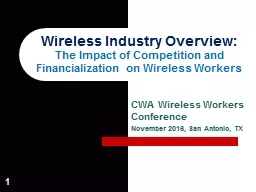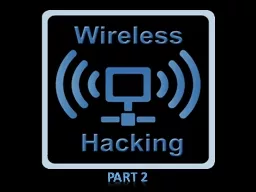1 Wireless Industry Overview: The Impact of
Author : tatiana-dople | Published Date : 2025-06-23
Description: 1 Wireless Industry Overview The Impact of Competition and Financialization on Wireless Workers CWA Wireless Workers Conference November 2016 San Antonio TX The Wireless Communications Industry is Dynamic Wireless coverage approaching
Presentation Embed Code
Download Presentation
Download
Presentation The PPT/PDF document
"1 Wireless Industry Overview: The Impact of" is the property of its rightful owner.
Permission is granted to download and print the materials on this website for personal, non-commercial use only,
and to display it on your personal computer provided you do not modify the materials and that you retain all
copyright notices contained in the materials. By downloading content from our website, you accept the terms of
this agreement.
Transcript:1 Wireless Industry Overview: The Impact of:
1 Wireless Industry Overview: The Impact of Competition and Financialization on Wireless Workers CWA Wireless Workers Conference November 2016, San Antonio, TX The Wireless Communications Industry is Dynamic Wireless coverage approaching 100%. Majority of households soon to be wireless-only Market penetration at 116% of subscribers Data is taking off! 2 Content Companies & Network Carriers in the Wireless Industry: A Virtuous Circle 3 Network Content Infrastructure: Cell sites Spectrum Satellites Fiber Copper Content: Web Sites Social Media Music Video VOIP Games Smart Car Smart Home Google, Netflix, Facebook, etc. AT&T, Verizon, T-Mobile, Sprint Services: Voice, Text, Email, Internet Access The Companies Who Build and Service the Networks Wired + Wireless 4 AT&T Verizon Pure Wireless T-Mobile Sprint New Entrants: Google Cable Cos. Networks Require Greater Investment than Apps & Social Media 5 Employment at the Network Carriers Leveling Off – but watch out for contractors 6 Contractors Wireless Market Share (and the fight over subscribers) 7 Source: FierceWireless, August 15, 2016 Price Competition Drives Down ARPU (average revenue per unit) 8 Negative ARPU trend puts pressure on network companies to deliver profits Company response: Sales programs to attract and retain customers “efficiency” programs to cut labor costs Company Response: Attract and Retain Customers Company Goals: Maintain current customers to stabilize churn Acquire new customers to increase profitability Increase number of devices, services, accounts per customer Company Tactics: Sales and marketing programs Bundling Early Termination Fee buyouts Free devices No contracts - EIPs Retention 9 Company Response: “Efficiencies” to Target Workers Company Tactics: Performance metrics Monitoring “At risk” pay Outsourcing Replace workers with technology Forced overtime Company Goals: Reduce overhead and labor costs 10 Outsourcing – Tactic to Cut Costs 11 Use non-union, low-wage call centers AT&T has presence in the Philippines, Mexico, and elsewhere VZ contracted out over 5,000 jobs in the Philippines, Dominican Republic, and Mexico TMUS has 17 in-house and 25 outsourced centers Sprint has cut 6,000 customer service jobs in three years due to technology and outsourcing Shift retail function to third-party, authorized dealers GameStop now owns 1,421 AT&T authorized stores 20% of 10,000 T-Mobile retail stores, are corporate owned All carriers sell through Best Buy, Costco, Target, etc. Unreasonable Metrics Drive Bad Customer Service 12 In This Competitive Environment, Some Prosper More than Others 13 Some Prosper More than Others, Part 2 14 Financial Strip Mining at AT&T and Verizon Financialization = Financial strip-mining: Company is














